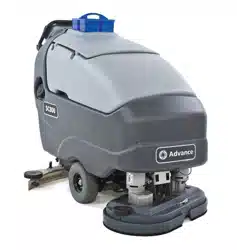Loading ...
Loading ...
Loading ...

Service Manual: SC750, SC800, SC 750 ST, SC800 ST
Form Number 56043150 Page 130
Solution System
Functional Description
The soluon system dispenses water and detergent to the scrub brush head for scrubbing the oor. The soluon tank
holds the soluon and serves as the main body of the scrubber. Soluon from the tank ows through a manual shut o
valve, lter, soluon valve (solenoid), manifold and out to the deck. Disc decks deliver the soluon on top of the disc
near the center. On Cylindrical decks the soluon is delivered through several small holes in manifold hoses along the
front of the deck. The soluon then drips through holes in the deck in front of the forward brush. The lter protects the
soluon valve from debris which can damage the valve. The manual shut o valve makes it possible to service plumbing
components without draining the soluon tank.
The standard soluon system requires the operator to mix a cleaning detergent with the water in the soluon tank. An
electric solenoid valve is used to turn the soluon ow on and o as well as to meter the amount of soluon used. The
soluon valve is controlled by the Main Machine Controller.
SC750 and SC800 models report soluon tank liquid level informaon to the operator on the Control Panel LCD. The
system does not measure the level of the water directly. It measures the pressure the water exerts on a pressure sensor
through a sealed hose. The higher the liquid level, the more pressure is exerted on the sensor. There is a pressure sensor
mounted on the main machine control board with a clear hose that connects to a ng on the soluon tank. On the
other side of the ng another hose goes into the tank. When the tank is lled with water/detergent, the liquid tries to
ll the hose but since the hose is sealed o it cannot displace the air in the hose and consequently cannot ll the hose
with liquid. It does exert pressure on the sensor which is converted to a voltage and “read” by the controller. This is like
holding your thumb over the top end of a drinking straw and inserng the straw into your so drink. The liquid does not
enter the straw because the air cannot escape out of the straw. What you don’t noce with your thumb is that the air
inside the straw is actually slightly pressurized by the liquid trying to displace the air.
On all machines, the Main Machine Controller turns the soluon ow on and o and meters the amount that ows via
an electric solenoid valve based on operator request and whether or not the machine is moving. The soluon solenoid
valve is spring loaded closed and must be energized to pull the valve open and allow soluon to ow. To control the
amount of soluon, the controller cycles the solenoid on and o at a slow rate. For low ow, the valve is on for about 1/3
of the me and o for 2/3 of the me. For medium ow, it is on about 2/3 of the me. For high ow it is on constantly.
The soluon is intenonally shut o whenever the machine stops moving.
The oponal detergent mixing system automacally mixes water from the soluon tank with detergent from a separate
detergent container. The operator lls the soluon tank with water only. The machine then automacally mixes the
correct amount of detergent and water and delivers it to the scrub brush head. A piston type detergent pump is used
to “inject” the detergent into the soluon hose. The controller keeps track of how many mes it has stroked the piston
pump and can calculate the level of liquid remaining in the detergent tank based on how many strokes it has counted. In
order for this to work though, the operator must “tell” the controller when a full detergent tank is installed so that the
controller can reset its counter and start again at the beginning. The detergent is injected into the soluon hose “before”
the soluon solenoid valve. The water and detergent mixture is then regulated by the solenoid valve.
Here is how the soluon electrical circuit works. In order to understand whether the machine is moving or not, the Main
Machine Controller sends 24v out through a resistor on a WHT/RED wire to the drive motor controller. The drive motor
controller has an internal switch that switches the circuit to baery negave whenever the machine is moving. The Main
Machine Controller has an internal voltmeter that monitors the circuit. When it sees 24 volts, it knows the machine is
standing sll. When it sees the voltage drop to near zero it knows the machine is moving and it then turns on the solu-
on ow. To make the soluon ow, the key switch provides baery posive (B+) voltage to the soluon solenoid valve.
The voltage goes through the solenoid winding and on to the Main Machine Controller. The controller completes the
circuit to baery negave (B-) through an internal switch causing the solenoid to energize and open the valve. If the
Loading ...
Loading ...
Loading ...
